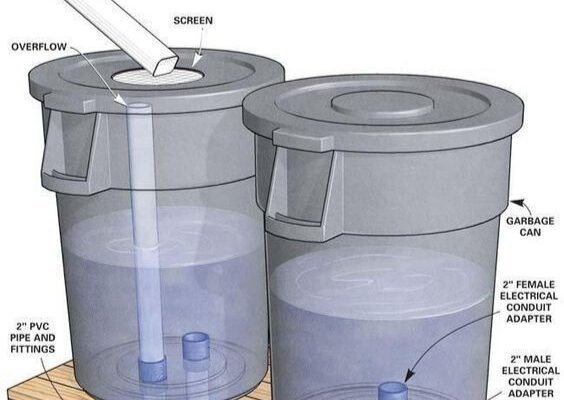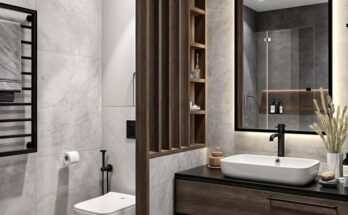This detailed illustration showcases a do-it-yourself rainwater harvesting system utilizing two repurposed garbage cans as collection barrels. The diagram meticulously labels the various components and their connections, providing a clear understanding of how such a system can be assembled to collect and utilize rainwater. Let’s break down the key elements:
1. Collection Barrels:
- Garbage Cans: The primary collection vessels are two standard-sized garbage cans, likely made of durable plastic. Repurposing these containers offers an economical and sustainable approach to rainwater harvesting. The cans are shown with lids, which likely have modifications for water entry and overflow.
- Screen: At the top of the first garbage can, a screen is visible. This crucial component filters out leaves, debris, and insects from the incoming rainwater, preventing contamination of the stored water and potential clogging of the plumbing.
- Water Level: The illustration shows both garbage cans partially filled with collected rainwater, indicating the system in operation.
2. Inlet and Overflow System (First Barrel):
- Downspout (Implied): While not explicitly shown connecting directly, the angled pipe entering the top of the first barrel represents the inflow of rainwater diverted from a roof downspout.
- Overflow (First Barrel): Near the top of the first barrel, an overflow pipe is depicted. This allows excess water to escape once the barrel is full, preventing overfilling and potential damage to the system or surrounding area.
3. Interconnection and Outlet Plumbing:

- 2″ PVC Pipe and Fittings: The plumbing connecting the two barrels and leading to the outlet utilizes 2-inch PVC (Polyvinyl Chloride) pipes and various fittings. PVC is a common and cost-effective material for non-pressurized water systems.
- 2″ Male Electrical Conduit Adapter & 2″ Female Electrical Conduit Adapter: These adapters are used to create a watertight connection between the PVC pipes and the threaded openings on the garbage cans. Electrical conduit adapters are often employed in DIY rainwater harvesting systems due to their robust and sealable design.
- 2″ x 1-1/2″ x 2″ Tee: A tee fitting connects the outlet of the first barrel to the second barrel and also provides a downward path for the main water withdrawal line. The reduction in size to 1-1/2 inches likely optimizes flow or connects to a different size of subsequent piping.
- Unions: Two unions are strategically placed in the horizontal PVC pipe run connecting the barrels. Unions are fittings that allow for easy disassembly of the plumbing for maintenance, cleaning, or winterization without having to cut the pipes.
- 1-1/2″ PVC Pipe and Fittings: The main water withdrawal line extending downwards from the tee utilizes 1-1/2 inch PVC pipe and fittings. This line directs the collected rainwater towards the point of use.
- Valve: A shut-off valve is installed on the 1-1/2 inch PVC pipe. This allows the user to control the flow of water from the storage barrels.
- Garden Hose Adapter: At the end of the withdrawal line, a garden hose adapter is connected. This enables easy attachment of a standard garden hose for watering plants, washing equipment, or other non-potable water uses.
4. Overflow (Second Barrel):
- A separate overflow pipe extends from the second garbage can. This ensures that if the first barrel fills and overflows into the second, any excess beyond the capacity of the second barrel can also be safely diverted away.
5. Support Structure:
- The two garbage cans are elevated on a sturdy wooden support structure. Raising the barrels allows for gravity-fed water flow through the plumbing and makes it easier to access the outlet valve and attach a hose. The structure appears to be constructed from dimensional lumber, securely fastened together.
System Operation:
Rainwater flows from the roof downspout into the first garbage can, passing through the screen to remove debris. Once the first barrel is full, excess water flows through the connecting PVC pipe into the second barrel. Both barrels store the collected rainwater. When needed, the user can open the valve on the 1-1/2 inch PVC pipe and connect a garden hose via the adapter to utilize the stored water. Any excess water beyond the capacity of both barrels is directed away through the overflow pipes.
Educational Value:
This illustration serves as an excellent visual guide for individuals interested in setting up a simple and effective rainwater harvesting system. It clearly demonstrates the necessary components, their connections, and the overall functionality of a dual-barrel setup. This type of system can help conserve water, reduce stormwater runoff, and provide a free source of water for various non-potable uses around the home and garden. The use of readily available materials like garbage cans and standard PVC plumbing makes this a feasible DIY project.



